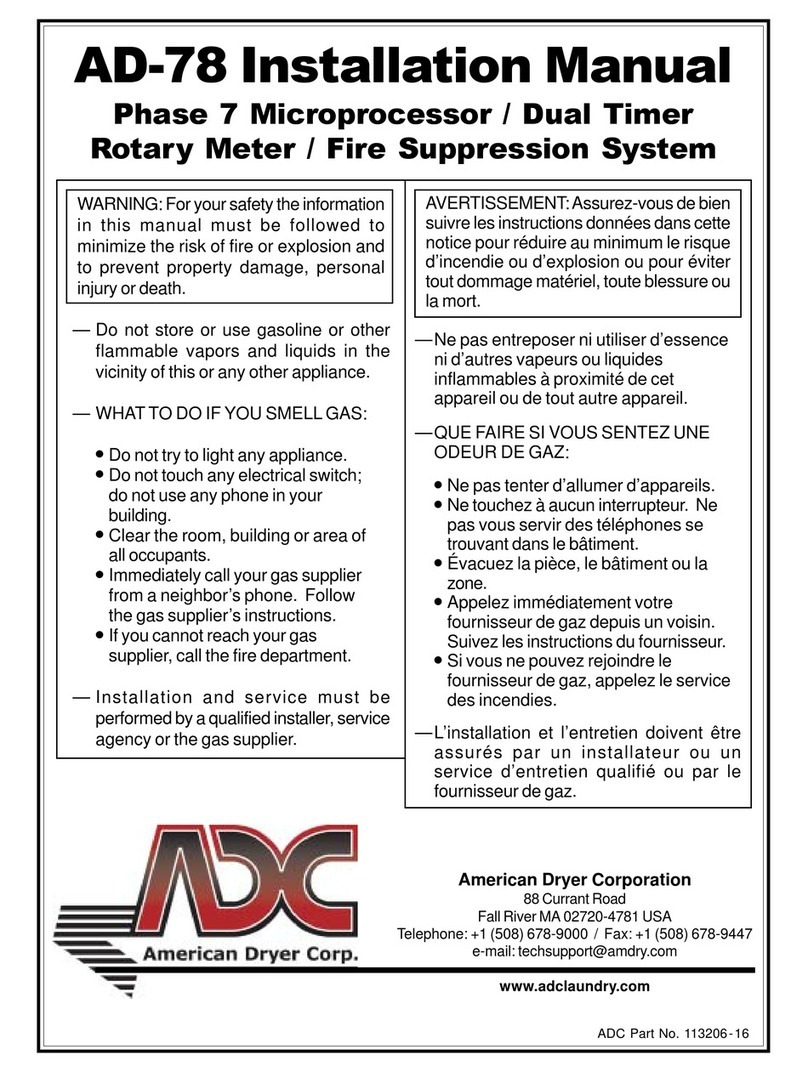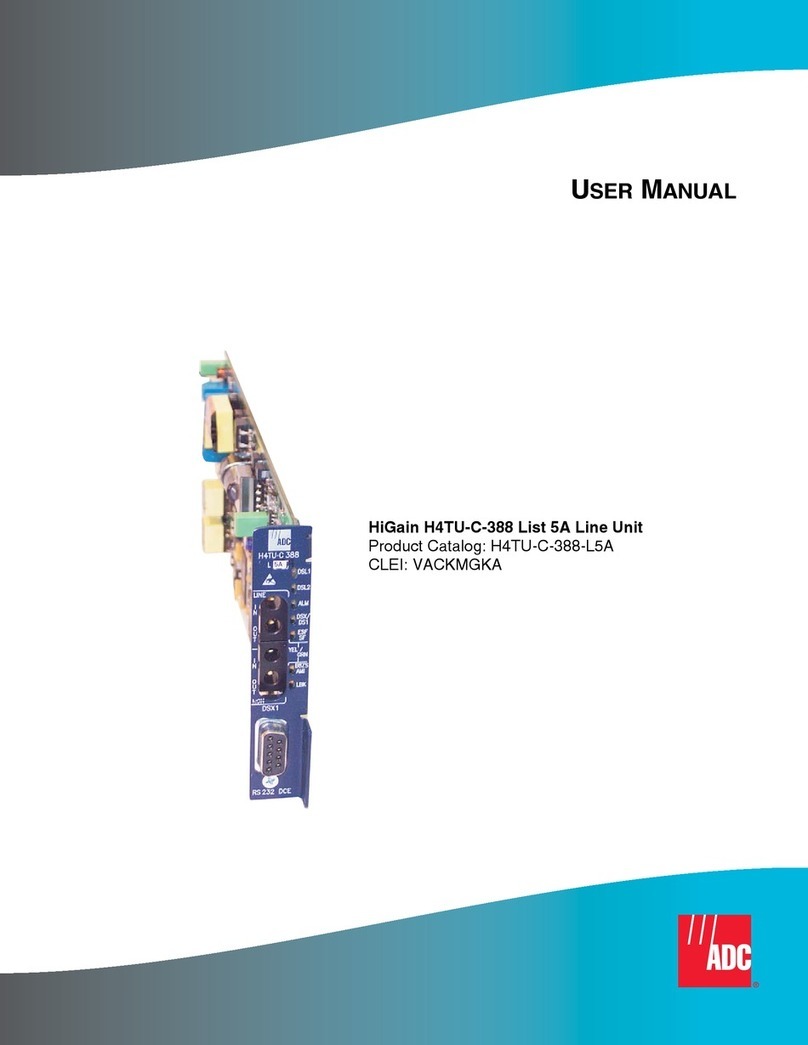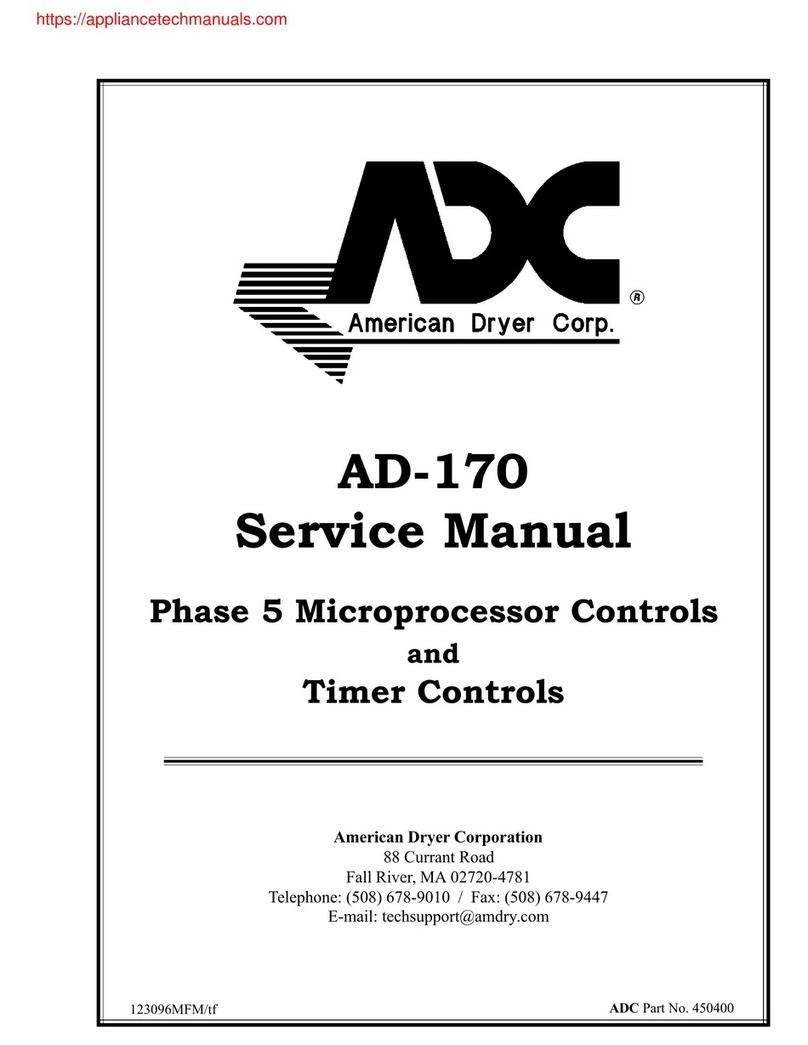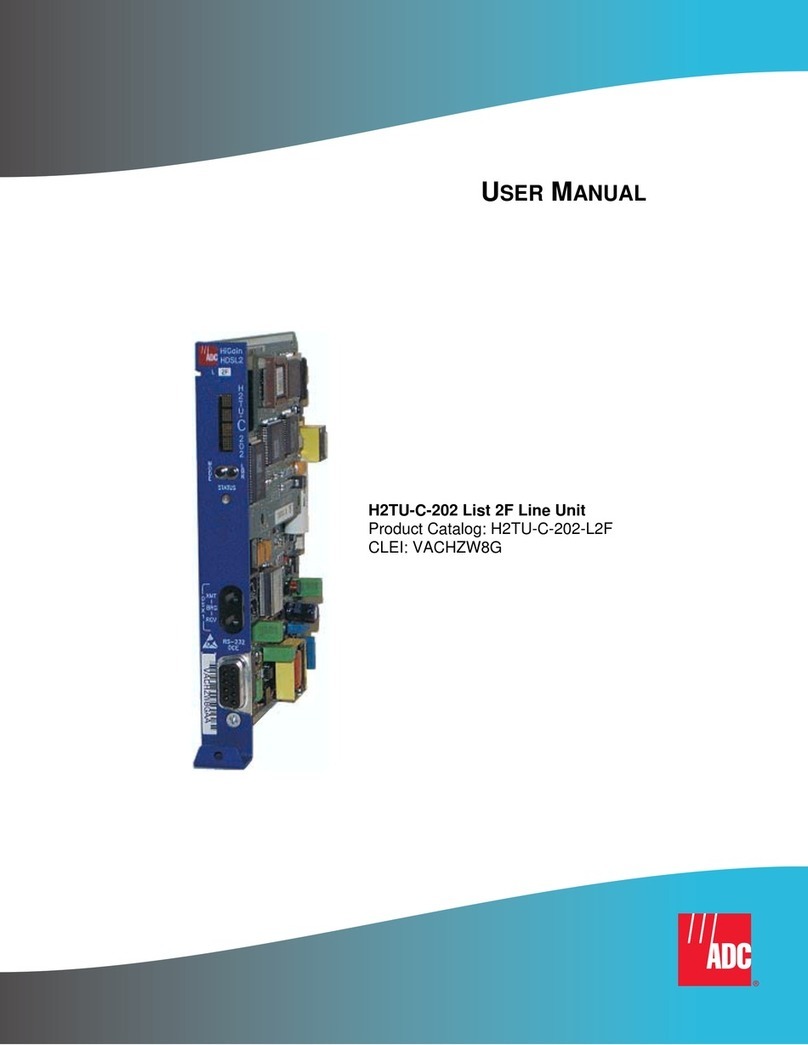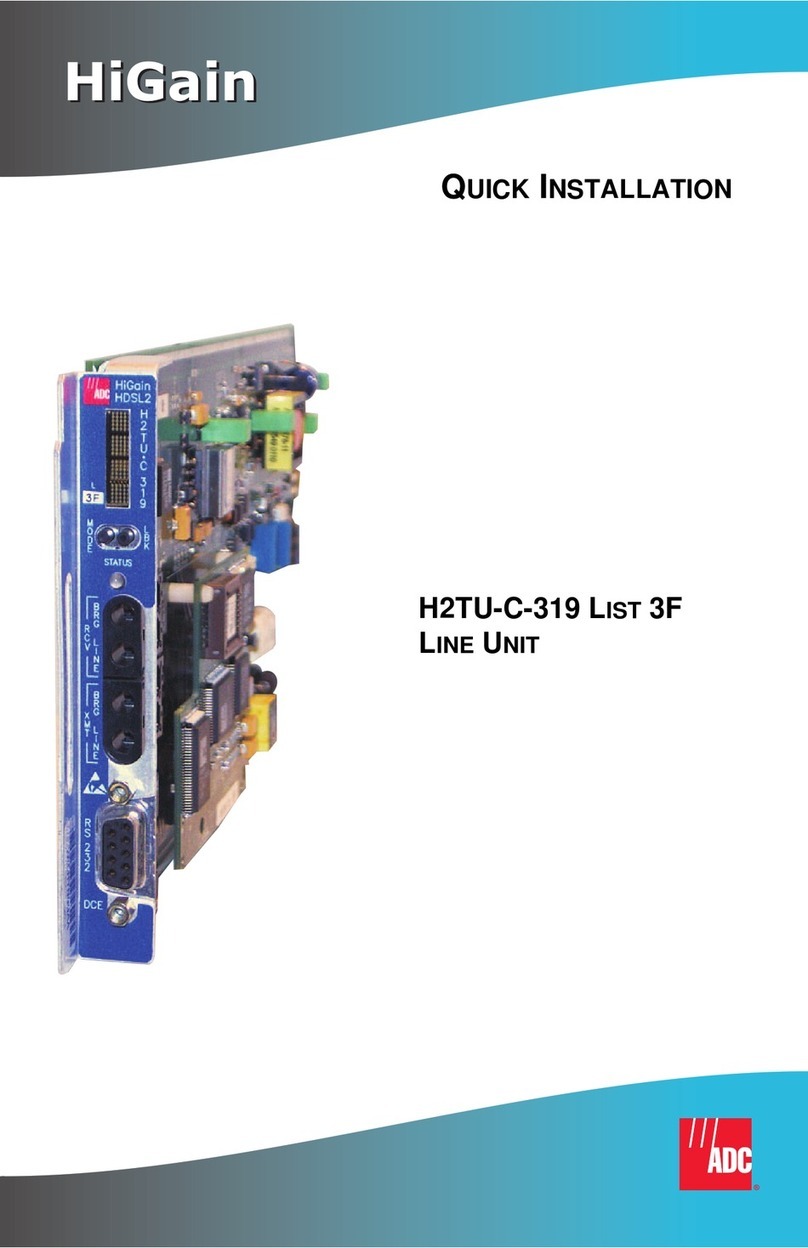
LOOPBACK TESTING
Initiate loopback testing from the HiGain maintenance menus or use the MODE and SEL
buttons. The hexidecimal inband codes shown below can be sent by a test set.
S
E
L
M
O
D
E
HLU-319
HiGain HD
L5D
R
C
V
B
R
G
M
A
R
G
I
N
(dB)
B
R
G
X
M
T
L
I
N
E
L
I
N
E
R
S
2
3
2
SETUP
STATUS
Four-character display
System option buttons (for manual setting of
system parameters)
DSX-1 test access jacks
CLEI and ECI
bar code label
List number
(HLU version
number)
Displays status, provisioning, and
alarm messages. See the
table below for a list of message
descriptions.
Front Panel Alarm Messages
Use MODE and SEL to manually modify user options,
initiate loopbacks, and display DSX-1 line parameters.
Connect standard test equipment.
SPAN
BRG
Provides splitting jack access to
(XMT) and from (RCV) the HDSL span
at the DSX-1 interface.
Provides non-intrusive bridging jack
access to (XMT) and from (RCV) the
HDSL span at the DSX-1 interface.
Allows monitoring of the T1 payloads.
Craft port provisioning
To access all system maintenance, provisioning
and performance screens, connect a standard
9-pin terminal cable between the serial port on a PC
and the HLU craft port.
1
2
3
4
Press the MODE button for 2 seconds and release.
The front panel alternately displays the first
system parameter and its current setting.
Press SEL to step through all possible settings for
the displayed parameter.
Press MODE to update the parameter and advance
to the next parameter.
After scrolling through all the parameters, press SEL
to confirm changes when prompted with a CONF YES
message, or press MODE to cancel all changes.
1200-9600 baud
8 data bits
No parity
1 stop bit
Hardware flow control:NONE
Terminal emulation
software:VT-100
Status LED
Reports the following conditions:
Self Test is in process or
a CREM or NLOC loopback
is in effect.
Green LED Normal operation
Flashing Green LED HDSL acquisition
Red LED Fuse alarm
Flashing Red LED System alarm
Yellow LED
FlashingYellow LED System is in ARM mode.
3
4
5
6
C
D
E
F
H7
8
J
9
K
10
L
Ground
HDSL1-T HDSL1-R
HDSL2-R1HDSL2-T1
Systemalarm** Mgmt.bus
Frameground -48Vdc BAT
Fusealarm*
Factory burn-in
(Donot use)
1
A
DSX-1TX-T DSX-1TX-R
2
B
DSX-1 RCV-T1 DSX-1RCV-R1
Fuse alarm
System alarm
Normal = Floating (+5 to -60 Vdc maximum)
Activated = +5 Vdc, 10mA maximum
Normal = Floating (0 to -60 Vdc maximum)
Activated = -48 Vdc, 10mA maximum
*
**
Card-edge Connector Front Panel
Modem settings:
A5LB Special Loopback Commands
Inband Code
11000. . . ARMING or NI LPBK (2-in-5 arming code)
11100. . . IR LPDN or DISARM (3-5 disamarming code)
D3D3 IOR LPBK (NLOC and CREM 230-232 bit errors and 229-231 bit errors)
C741 ILR-1 LPBK (NDU1 and CDU1 10 bit errors)
C754 LR-20 LPBK (NDU2 and CDU2 200 bit errors)
C743 ILR-3 LPBK (NDU3 and CDU3 30 bit errors)
C744 ILR-4 LPBK (NDU4 and CDU4 40 bit errors)
C742 ILR-2 LPBK (NREM and CLOC 20 bit errors)
For more detailed information about the maintenance terminal
screens, provisioning, and loopback mode testing, refer to the
HLU-319 List 5D technical practice, document number 150-319-154-xx.
Copies of this publication or the technical practice can bedownloaded
from the ADC website at
www.adc.com
. To order a hard copy, please
contact your sales representative.
Front Panel Alarm Messages
Message Description
ALRM A system alarm condition is in effect.
ACO A system alarm has been retired to an alarm cutoff condition by pressing the SEL button.
LOSW Indicates that one of the HDSL loops has lost sync.
LLOS Indicates that no signal is detected at the DSX-1 input to the HLU.
RLOS Indicates that no signal is detected at the DSX-1 input to the HRU.
MAL1 or MAL2 The margin on HDSL Loop 1 or Loop 2 has dropped below the threshold (1 to 15 dB)
setting.
BER A system Bit Error Rate alarm is in effect.
NONE No alarm present.
Front Panel Diagnostic Messages
Message Description
1=xx or 2=yy Indicates the power of the received HDSL signal on each loop relative to noise. Any value
of 06 or greater is adequate for reliable system operation.
ACQ1 or ACQ2 The multiplexers of the HLU and the HRU or the first doubler are trying to establish
synchronization over Loop 1 or Loop 2 of Span 1.
AnL1 or AnL2 The multiplexers of the two devices on Span nare trying to establish synchronization with
each other on Loop 1 or Loop 2, where nis the number of the span.
BAD RT? The HLU is not receiving any response from the HRU.
CODE xxxx The line code setting, where xxxx is Alternate Mark Inversion (AMI) or Bipolar with 8-Zero
Substitution (B8ZS).
FERR Framing bit error occurred at HLU DSX-1 input.
FRM xxxx Determines the type of frame pattern being received from the DSX-1 where xxxx is SF,
ESF, THRU, or NONE.
H1ES or H2ES HLU HDSL Loop 1 or Loop 2 CRC error.
nHDU Number (n) of doublers in the circuit.
INSL, then xxDB The maximum Insertion Loss message (INSL) appears followed by xxDB, where xx is the
maximum insertion in dB of all spans and loops.
LBPV A local bipolar violation has been received at the DSX-1 input to the HLU.
MNGD The HLU is under control of the HMU-319 Network Management Unit.
PWRF GND One of the HDSL loops has been grounded.
PWRF ON Indicates that the HDSL loops are not grounded or shorted.
PWRF OFF HDSL span power has been turned off.
PWRF SHRT Indicates a short between the two HDSL pairs or the inability of the HRU to communicate
with the HLU.
SELF TEST The HLU is in a self-test mode. This occurs every power on/off cycle.
SIG1 or SIG2 The transceivers of the HLU and HRU or first doubler are trying to establish contact with
each other on Loop 1 or Loop 2 of Span 1.
SnL1 or SnL2 The transceivers of the two devices on Span nare trying to establish contact with each
other on Loop 1 or Loop 2, where nis the number of the span.
System Settings
Display Code Description (default values in bold)
EQL Sets the equalizer to DSX-1 for: 0 (0 to 133 ft.), 133 (133 to 266 ft.), 266 (266 to 399 ft.),
399 (399 to 533 ft.), 533 (533 to 655 ft.)
LBPK Enables (ENA) or disables (DIS) all inband SMJK loopback commands
PWRF DIS = disables HDSL powering
LOW = HDSL line voltage is -140 V max.
AUTO = automatically switches between -140 V for nondoubler applications and ±112 V
for doubler applications)
HIGH = ±112 V for all applications
BERT NONE = prevents generation of a system alarm due to excessive BER
1E-6 or 1E-7 = alarm activates when BER threshold exceeds 10-6 or 10-7
LBTO Loopback timeout = NONE, 20, 60, 120 minutes
ALM Enables (ENA) or disables (DIS) the alarm relay
LNCD Line code = places the HLU and HRU in B8ZS or AMI mode
SAIS Enables (ENA) or disables (DIS) transmission of AIS signal during NREM/SMJK loopbacks
MARG 0 to 15 dB (can only be set through a maintenance terminal connected to the craft port);
the default is 4dB
RDA Enables (ENA) or disables (DIS) alarm indications due to remote DS1 LOS at HRU input
ALMP Enables a line to output an (AIS) payload of all ones or an (LOS) condition at its DS1 ports
for LOSW, DS1, LOS and margin alarms
RTPV Enables (ENA) provisioning at the remote (when remotely logged in) or disables (DIS)
provisioning at the remote
BPVT Enables (ENA) or disables (DIS) bipolar violation transparency (conversion of input DS1
BPVs and HDSL CRC errors into DS1 BPVs at the distant end’s DS1 output port)












